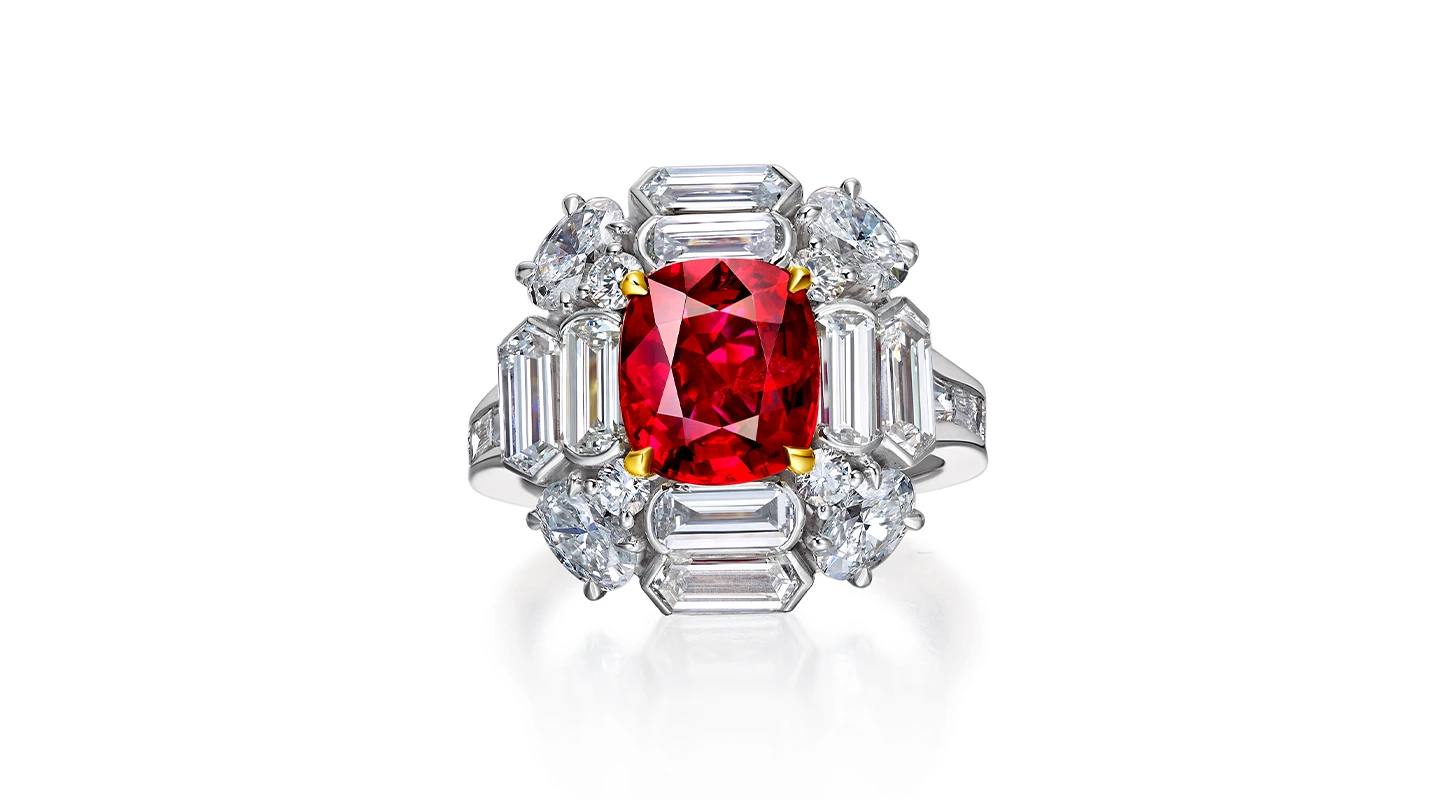Courtesy of Faidee
A striking contrast of fire and ice, this dazzling ring showcases a 2.08-carat unheated “pigeon’s blood” ruby, complemented by 3.98 carats of brilliant diamonds.
Captivating hearts for centuries with their beauty and brilliance, rubies and diamonds are among the world’s most treasured gemstones. But when it comes to choosing between them, how do you decide?
Each stone carries a legacy of grandeur and unique appeal. Diamonds, symbolizing eternity, offer classic brilliance and unmatched versatility. Rubies, associated with passion and vitality, stand out for their bold, vibrant color.
Before deciding on a ruby, a diamond or both, it’s worth exploring what makes each gem truly exceptional. From their physical properties, maintenance and price considerations to their meaning and aesthetics, each tells a distinct story. Whichever you choose, you’ll be adding a piece of rare beauty and timeless significance to your collection.
What is a Diamond?
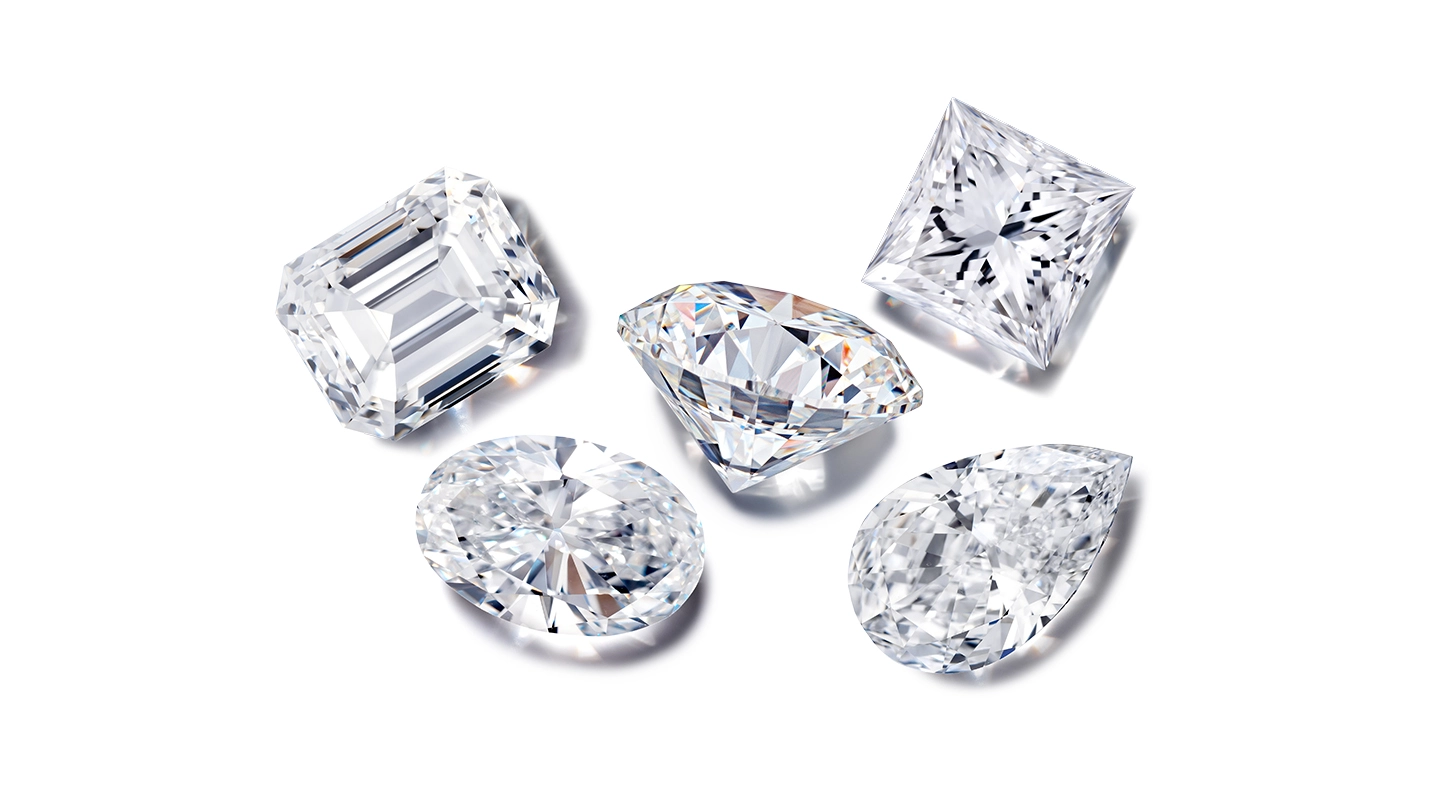
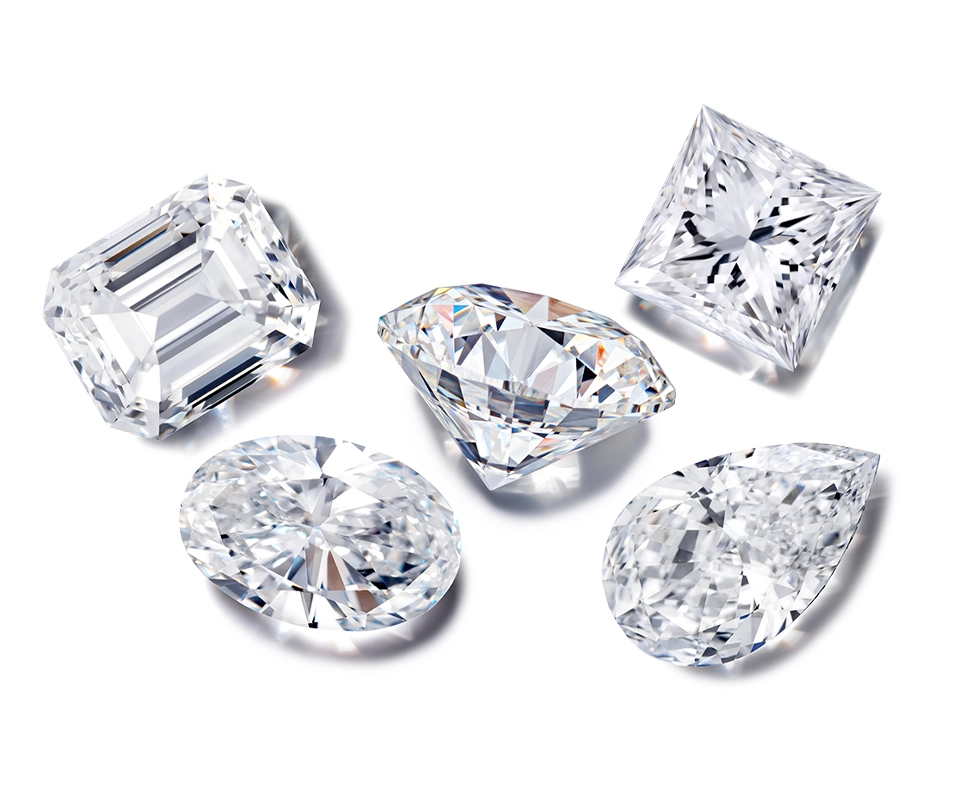
A diamond is a precious gemstone known for its unmatched hardness and brilliance. Composed almost entirely of carbon, it forms deep within the Earth’s mantle under extreme heat and pressure. These conditions create a tightly bonded crystal structure, making diamond the hardest naturally occurring substance on Earth. While most diamonds range from colorless to light yellow or brown (graded on the D-to-Z color scale), they also appear in rare fancy colors such as blue, green and pink.
Diamonds have long been prized for their beauty and rarity, with some historians dating diamond trading back to the 4th century BC in India. Symbolizing enduring love and strength, and serving as April’s birthstone, they are a popular choice for fine jewelry and engagement rings. The value of diamond is largely determined by The 4Cs of Diamond Quality: color, clarity, cut and carat weight. Each of these factors plays a crucial role in a diamond’s beauty and price.
What is a Ruby?
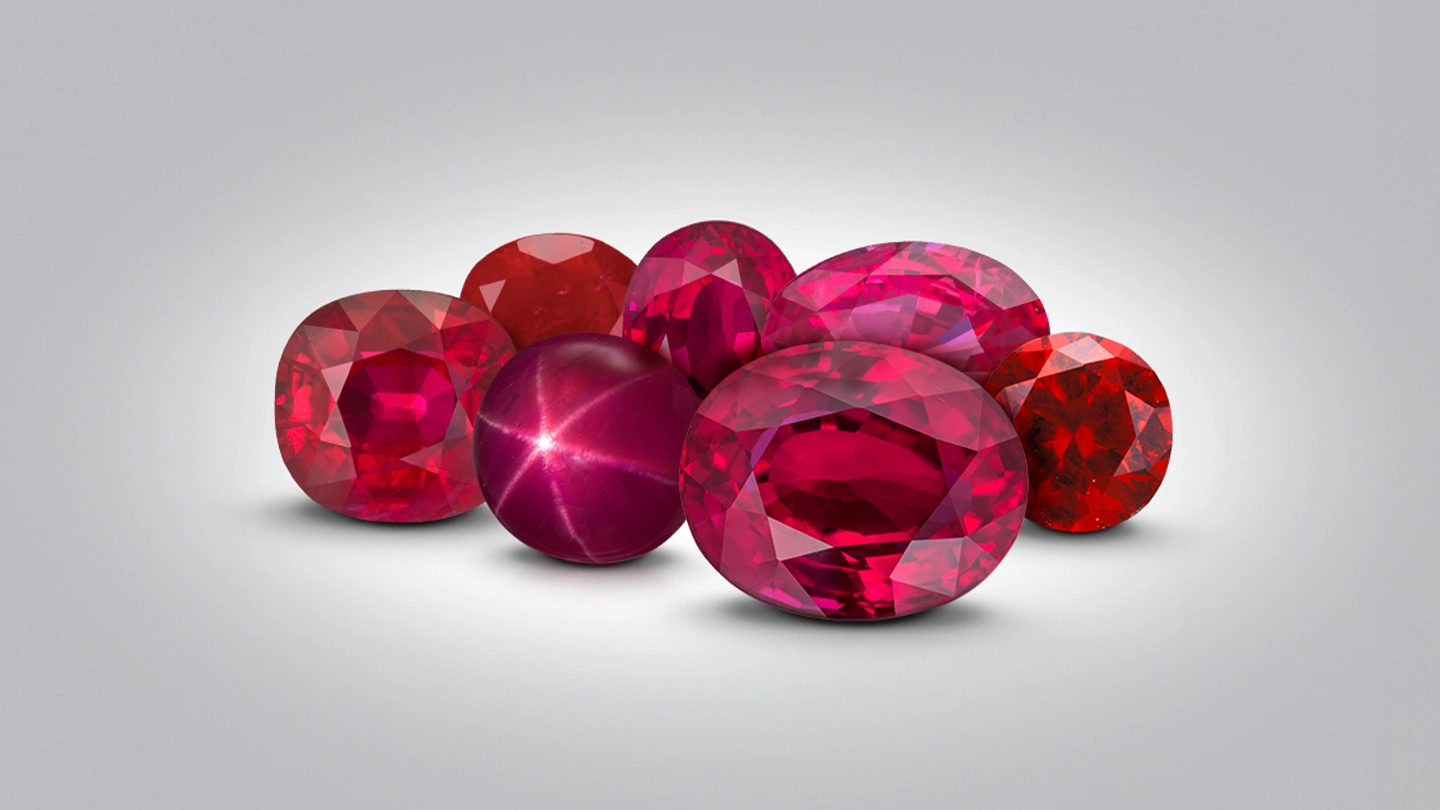
These luscious rubies, ranging from red to purplish red, give off a fiery glow.
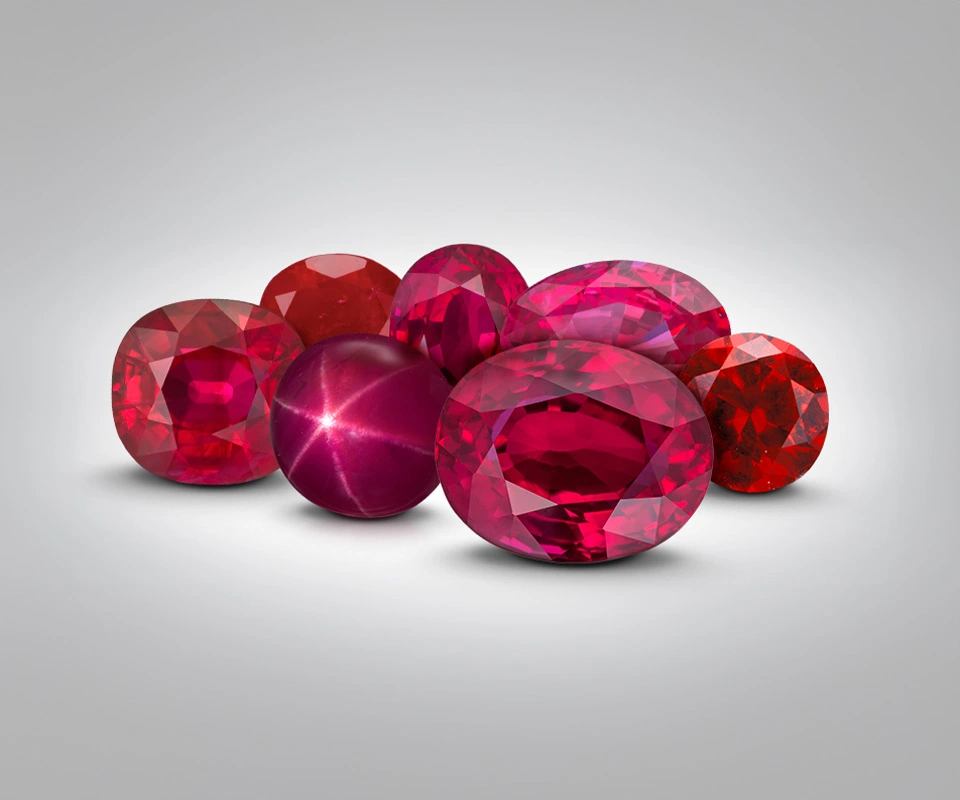
These luscious rubies, ranging from red to purplish red, give off a fiery glow.
Ruby is a striking red gemstone celebrated for its vibrant color. Ranking second only to diamonds in hardness and boasting exceptional toughness—strong resistance to breaking, chipping or cracking—rubies are remarkably durable, making them ideal for everyday wear.
Their deep red hue, often associated with passion and vitality, has made them highly coveted throughout history. Cherished for millennia, rubies appear in royal regalia and ancient texts, symbolizing love, power and protection. The most prized rubies display a vivid red to purplish-red color, commonly known as “pigeon’s blood.”
In Sanskrit, ruby is known as ratnaraj, meaning “king of precious stones”—a name that reflects its revered status. Rubies are believed to bring good fortune to their wearers. As the July birthstone and a symbol of the 40th wedding anniversary, they remain a meaningful and enduring choice for fine jewelry and engagement rings.
Ruby vs. Diamond: How Do They Form?
Origins of Diamonds
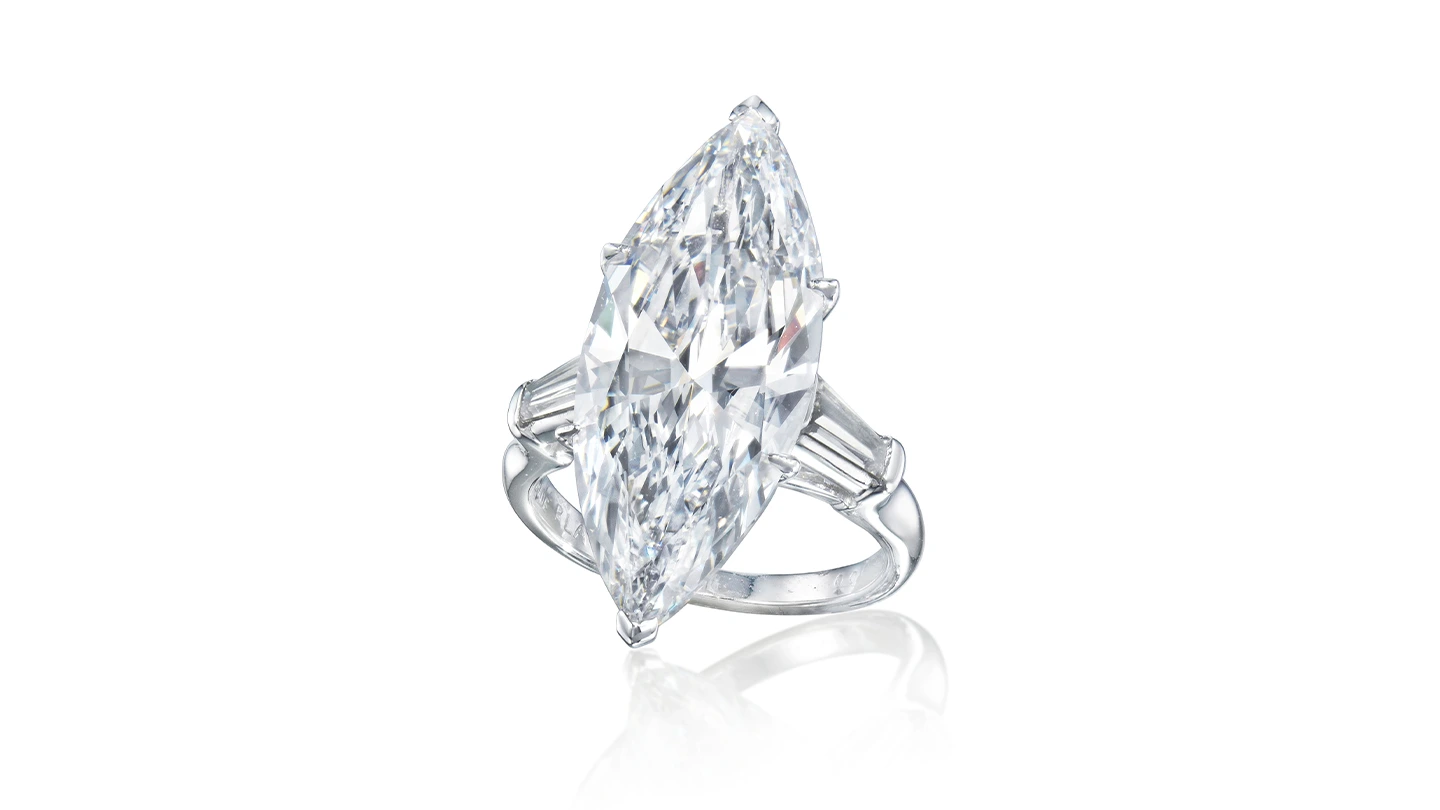
Glamorous and dramatic, this ring features a 10-carat, E color, Internally Flawless marquise cut diamond flanked by tapered baguette-cut diamonds.
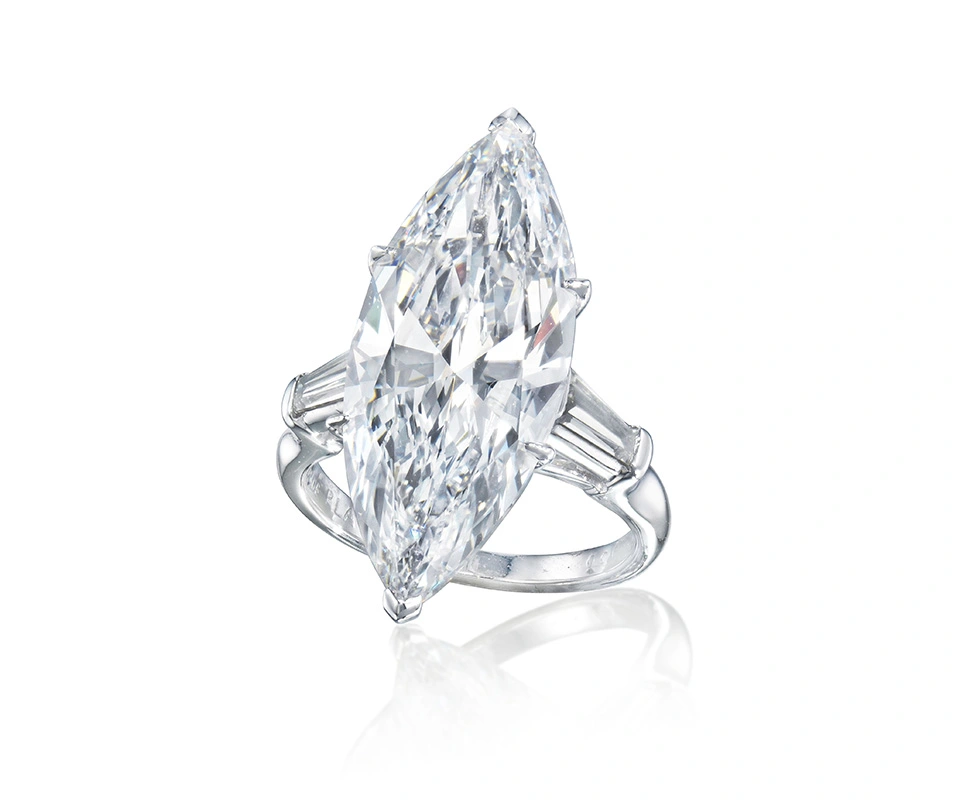
Glamorous and dramatic, this ring features a 10-carat, E color, Internally Flawless marquise cut diamond flanked by tapered baguette-cut diamonds
Natural diamonds form deep within the Earth, where intense heat and pressure cause carbon atoms to crystallize into diamond. Remarkably, they are the gemstone that develops at the greatest depths beneath the surface. Once mined, rough diamonds are expertly cut and polished by skilled artisans to reveal their stunning brilliance.
In contrast, laboratory-grown diamonds—also known as lab-created, man-made, or synthetic diamonds—are produced through processes that fundamentally differ from natural diamond formation. They are grown in factories using two primary methods: High Pressure High Temperature (HPHT), which imitates the natural conditions of diamond formation in Earth’s mantle, and Chemical Vapor Deposition (CVD), which grows diamonds from carbon-rich gas in a vacuum chamber.
These diamonds share similar chemical, optical and physical properties as natural diamonds and may be hard to tell apart via the unaided eye after cutting and polishing. However, striking differences in crystal shape, inclusions, growth patterns and fluorescence reveal their distinct origins, making them readily identifiable to trained gemologists and expert laboratories like GIA.
Famous Diamonds
Throughout history, diamonds have fascinated collectors and connoisseurs with their unmatched brilliance and rarity.
One of the most legendary diamonds is the Cullinan Diamond, the largest rough gem-quality diamond ever found, weighing an astonishing 3,106 carats. Discovered in South Africa in 1905, the Cullinan was expertly cut into several stones, the largest of which, the Cullinan I or Great Star of Africa, is a remarkable 530.2-carat pear-shaped gem currently set in the British Crown Jewels.
Another iconic gem is the Hope Diamond, famed not only for its exceptional 45.52-carat weight but also its deep blue color, red fluorescence, storied history and reputed curse. Reportedly originating from India, this rare blue diamond has passed through royal hands and prestigious collections before finding a permanent home at the Smithsonian Institution, where it continues to captivate visitors from around the world.
Today, diamonds remain at the forefront of luxury and fashion. Celebrities like Rihanna, Beyoncé and Jennifer Lopez frequently showcase stunning diamond jewelry on the red carpet, proving that these gems continue to symbolize elegance, strength and timeless beauty.
Origins of Rubies
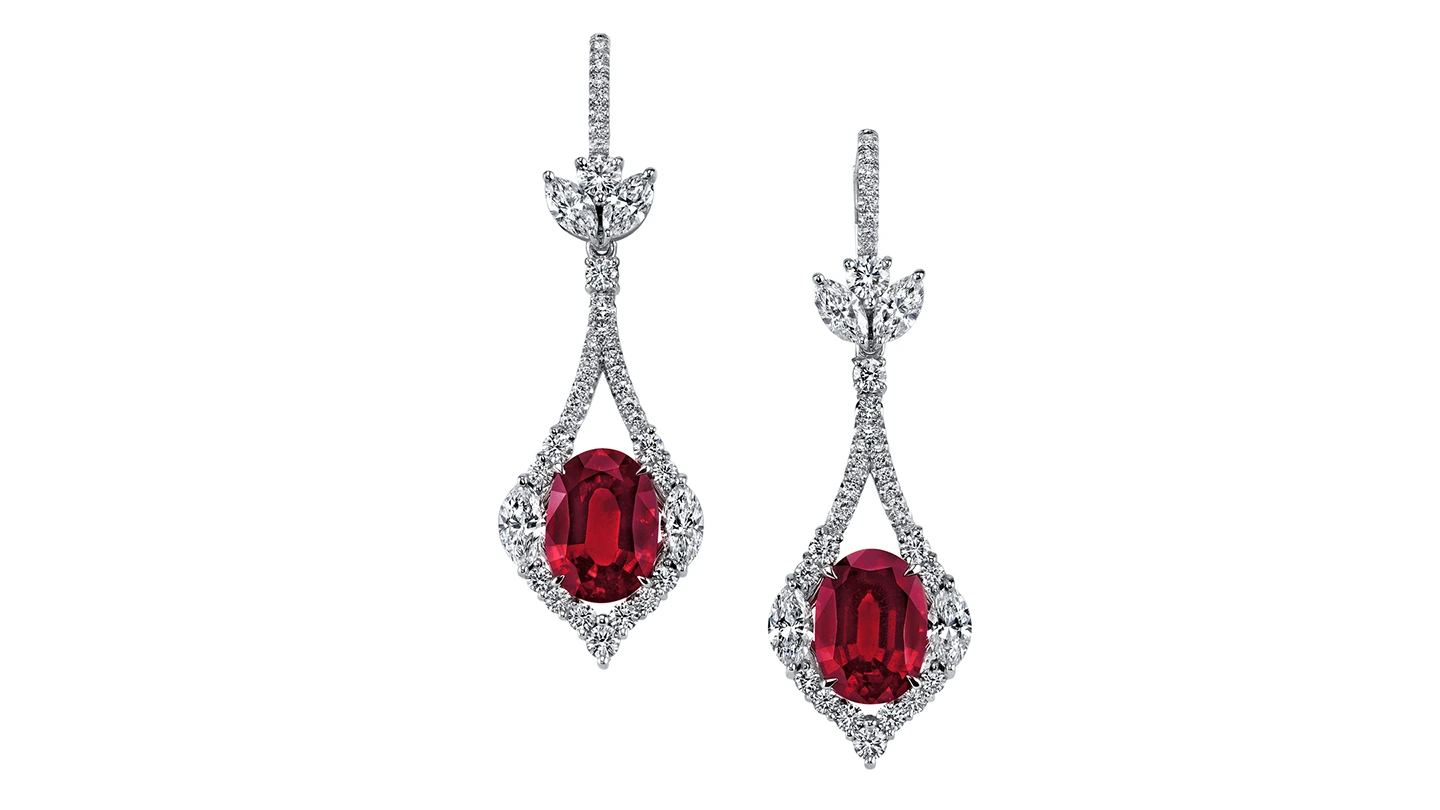
These timeless long drop earrings showcase 8.16 carats of vivid rubies, complemented by 3.47 carats of sparkling diamonds.
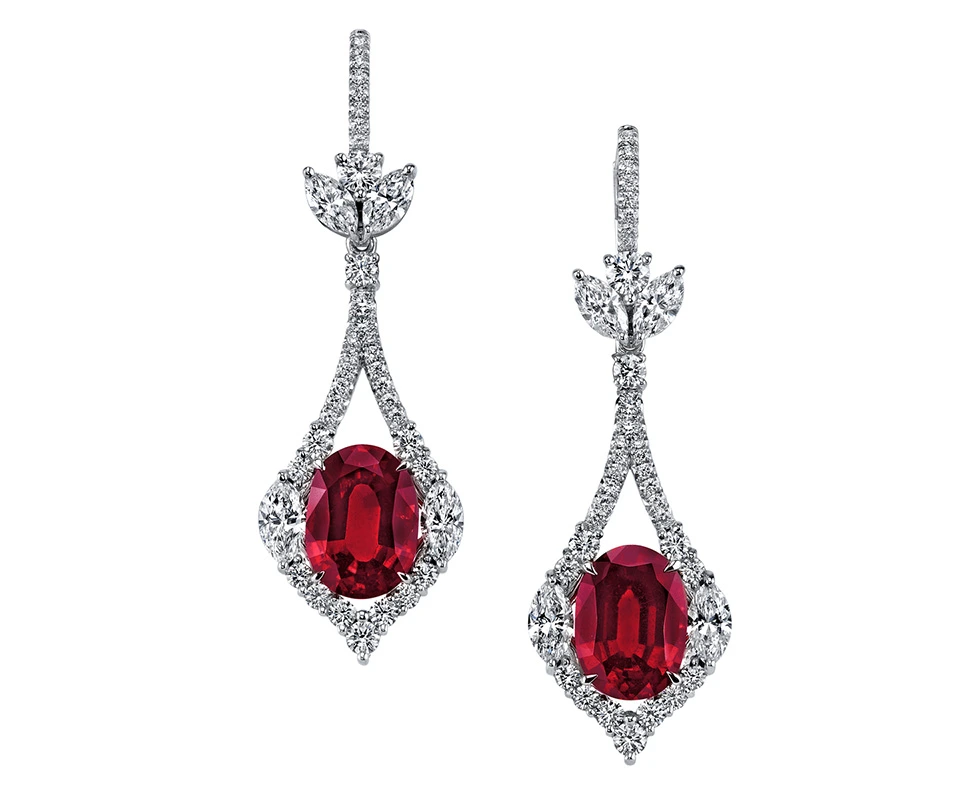
These timeless long drop earrings showcase 8.16 carats of vivid rubies, complemented by 3.47 carats of sparkling diamonds.
Rubies form deep within the Earth under intense heat and pressure, where aluminum and oxygen bond to create the mineral corundum. When chromium is present, it causes the crystal to absorb most wavelengths of light and reflect only red, resulting in the ruby’s rich, vibrant color.
Today, some of the world’s finest rubies come from Mozambique and Myanmar (formerly Burma), with additional sources found across Southeast Asia, the Himalayan region and East Africa.
In contrast, synthetic rubies are created in laboratories using methods such as the flame fusion or flux growth processes. The flame fusion method involves melting powdered chemicals in a high-temperature flame, causing the material to crystallize as it cools. Flux growth involves dissolving raw materials in a molten flux, allowing crystals to slowly form over weeks or months. While laboratory-grown rubies share similar chemical and physical properties as natural rubies, their growth patterns and internal features differ, helping gemologists distinguish between the two. In some cases, synthetic rubies may be flagged using the unaided eye or with the help of UV light, but the most reliable way to determine a ruby’s origin is to have it evaluated by a professional gemological laboratory, such as GIA.
A GIA Colored Stone Identification Report provides essential information about your gemstone’s identity and any detectable treatments, giving you confidence and clarity about exactly what you are purchasing.
Famous Rubies
Famous and historic rubies include the Sunrise Ruby, a stunning 25.59-carat Burmese ruby renowned for its vibrant pigeon’s blood red color—the most prized hue in rubies. This extraordinary gemstone set a world record for the highest price ever paid per carat when it sold for over $30 million at auction in 2015.
Another remarkable gem is the Estrela de Fura, a 55.22-carat cushion-cut pigeon’s blood ruby from Mozambique. This exceptional ruby fetched a record-breaking $34.8 million at Sotheby’s New York in June 2023, making it the most expensive ruby ever sold at auction to date.
Of course, no discussion of famous rubies would be complete without mentioning Elizabeth Taylor’s Burmese ruby engagement ring, a dazzling symbol of glamour and romance from one of Hollywood’s most iconic stars.
Today, rubies continue to dazzle under the spotlight. Celebrities like Scarlett Johansson, Taylor Swift and Kerry Washington have all turned heads on the red carpet wearing bold, ruby jewelry—showing that these gems remain a symbol of passion, power and prestige in the modern era.
Are Rubies More Expensive Than Diamonds?
When choosing between rubies and diamonds, understanding how price varies can help you make an informed decision. Both gemstones’ values depend heavily on quality, but key factors differ between the two.
Diamonds are traditionally graded according to the “4Cs”: carat weight, color, clarity and cut. Large, colorless diamonds with high clarity and excellent cut command premium prices.
Rubies, on the other hand, derive their value primarily from the intensity and purity of their color. The most coveted rubies exhibit a vivid, pure red hue often referred to as “pigeon’s blood.” While clarity does play a role in determining value, minor inclusions are generally tolerated if the color is exceptional. Large, high-quality rubies are significantly rarer than diamonds, which can make them more expensive at larger sizes.
Unlike with diamonds, a ruby’s value can be influenced by the ruby’s country of origin. Rubies from renowned sources—such as Myanmar (formerly Burma)—are especially sought-after and often command premium prices. In comparison, the origin of a diamond typically does not affect its value.
Price-wise, fine rubies in large sizes can sometimes exceed the per-carat price of diamonds. But fancy color diamonds in rare colors, such as red, green and blue, can exceed the per carat price of fine rubies.
In summary:
- Diamond prices depend on balanced excellence across the 4Cs.
- Ruby prices are driven most strongly by color, followed by carat weight and clarity. Treatment is also an important consideration.
- Both stones require reports from reputable labs like GIA to ensure identity and quality.
Choosing between the two ultimately comes down to personal preference, budget and the qualities you value most in a gemstone.
What Affects Ruby vs. Diamond Price?
For both stones, their rarity and beauty largely determine their worth. Let’s explore the various factors that go into valuing diamonds and rubies:
Gemstone Cut: Diamonds vs. Rubies
Diamonds
The quality of a diamond’s cut heavily factors into a diamond’s value. A well-cut diamond will reflect light internally from one facet to another, then disperse it through the top of the diamond, giving it extraordinary sparkle. In contrast, a poorly cut diamond can appear dull and lifeless as light leaks from the sides or bottom. The precision and craftsmanship of cutting techniques, including the angles and proportions of each facet, plays a crucial role in the diamond’s final appearance.
Only round brilliant diamonds receive GIA cut grades, which range from Excellent to Poor. Most round brilliants are expected to fall within the Excellent to Very Good range. Fancy cuts such as hearts, ovals and more, don’t receive cut grades but they are evaluated for symmetry and polish.
Rubies
Unlike diamonds, cut is not the primary value factor for rubies. Instead, rubies are shaped to enhance their color and preserve as much carat weight as possible. However, a well-cut ruby should still be symmetrical and well-polished to maximize its beauty.
Gemstone Color: Diamonds vs. Rubies
Diamonds
Diamond color grades can affect the stone’s visual appeal. Diamonds are graded on a color scale from D to Z. The scale measures the absence of color in a diamond, with D representing completely colorless stones and Z indicating noticeable color, usually a yellow or brown tint. Colorless diamonds (grades D-F) are the most sought-after because these diamonds are the rarest and “whitest” in appearance.
Rubies
When it comes to color, the “pigeon’s blood” ruby is considered the rarest and most valuable. However, high-quality rubies can exhibit a wide range of beautiful red hues. The most prized rubies have intense color saturation without being too dark or light.
The color of a ruby is determined by a combination of its hue, tone and saturation. The hue represents the primary color. While all rubies are essentially “red,” they can also exhibit purple or orange secondary hues. Tone indicates the lightness or darkness of the color, with the finest rubies having a medium to medium-dark tone. If the tone is too light, the stone may appear pink and be classified as pink sapphire instead. The saturation of a ruby measures color purity and intensity. Rubies with vivid or intense saturation are highly prized, whereas those with poor saturation appear brownish red.
Gemstone Clarity: Diamond vs. Rubies
Diamonds
Diamond clarity is graded on a scale ranging from Flawless (FL) to Included (I3). This scale assesses internal characteristics called inclusions and external characteristics known as blemishes. A flawless diamond has no inclusions or blemishes visible under 10x magnification, while an Included diamond has apparent inclusions that can affect its transparency, brilliance and even durability.
Clarity significantly impacts a diamond’s appearance and value. Diamonds with higher clarity grades are rare and command higher prices. However, many inclusions are microscopic and do not affect the beauty of the diamond to the unaided eye. Diamonds in the range of Flawless to VS1 don’t have any inclusions visible to the unaided eye.
Rubies
Clarity standards for rubies differ from those for diamonds. While diamonds are prized for purity and clarity, rubies often contain inclusions like needles, crystals, fingerprints and silk. Specific inclusions can even boost the gem’s value by diffusing light and improving its color. That said, highly visible or numerous inclusions can detract from a ruby’s transparency, brightness and even durability, reducing its overall appeal and worth.
Gemstone Carat Weight: Diamonds vs. Rubies
Diamonds
Carat weight significantly affects the price of a diamond. One carat is equivalent to 200 milligrams. As the carat weight increases, the cost of the diamond rises along with it. For example, a two-carat diamond is generally more than twice as expensive as a one-carat diamond of the same quality. This price increase is due to the rarity of finding larger diamonds with high clarity, color and cut grades.
However, carat weight isn’t everything. The size and physical dimensions of a diamond can be influenced by the stone’s shape and cut. Well-cut diamonds can appear larger and more brilliant than poorly cut diamonds of the same carat weight due to better light performance and ideal proportions. In these cases, a diamond of a lower carat weight could fetch a higher price than one of a larger weight.
Rubies
Carat weight also impacts the price of a ruby. Like diamonds, larger rubies are rarer and more valuable. However, the price increase with carat weight can be even more dramatic for rubies, particularly those with top color and clarity. Due to the rarity of larger stones, a top-quality three-carat ruby is exponentially more expensive than a similar-quality one-carat ruby—far exceeding three times the price.
Like diamonds, rubies are weighed in carats. However, ruby’s greater density means that a one-carat ruby may appear slightly smaller than a one-carat diamond when viewed side by side. The physical dimensions of a finished ruby can also vary depending on the cut, with shallower rubies appearing larger face-up for the same carat weight.
Should I Buy an Engagement Ring with Rubies or Diamonds?
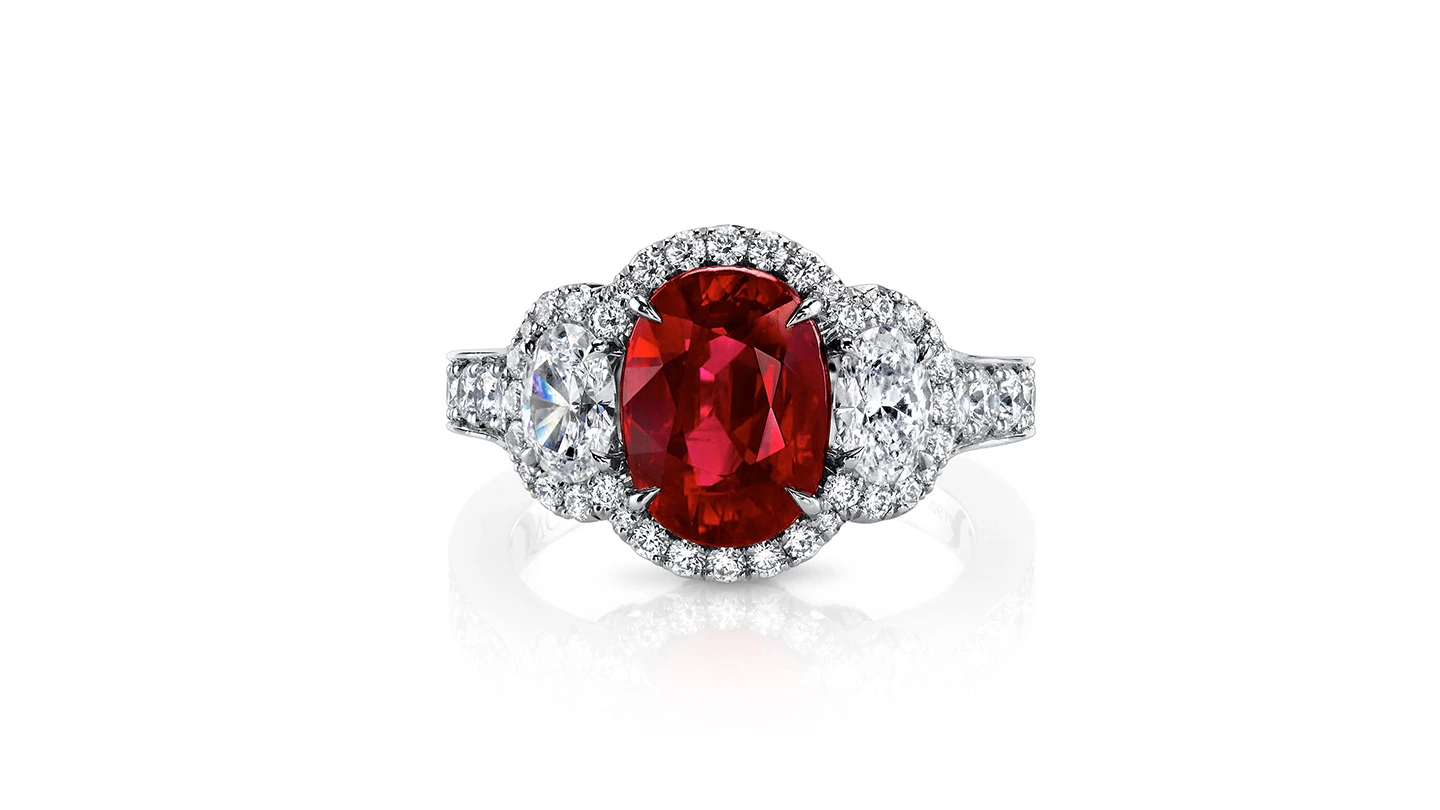
This classical three-stone ring features a captivating 3.46-carat ruby accented by dazzling diamonds.
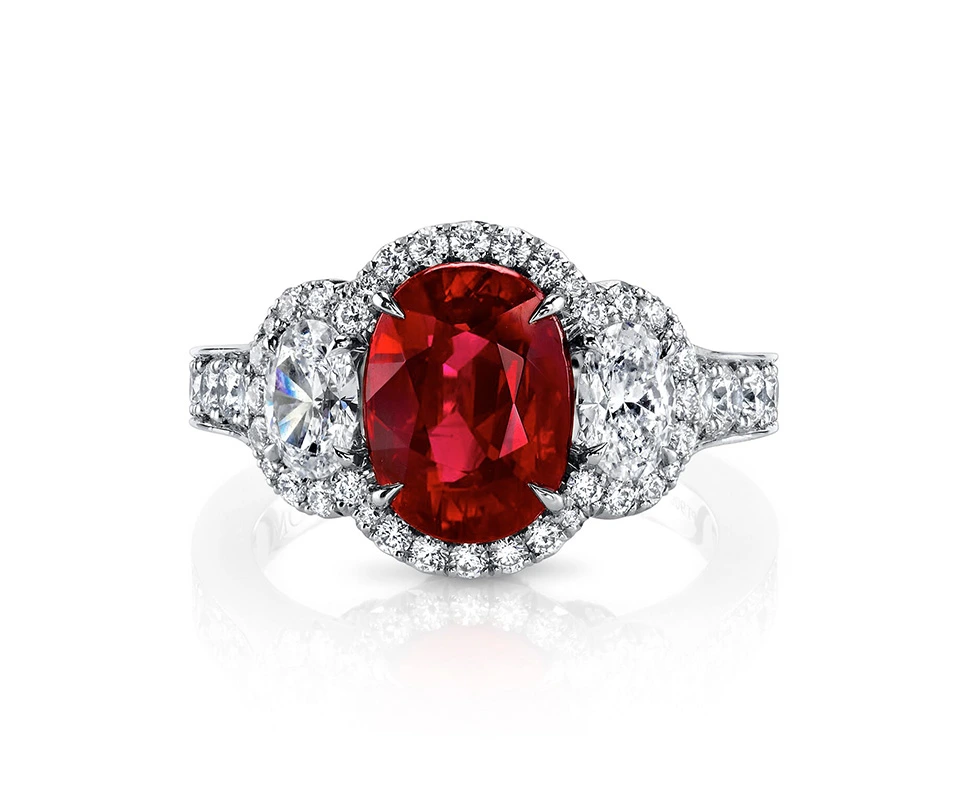
This classical three-stone ring features a captivating 3.46-carat ruby accented by dazzling diamonds.
Selecting a gemstone for your engagement ring or jewelry is a deeply personal decision. Whether you choose diamonds, rubies or a combination of both, here are some important factors to consider:
- Personal Style: Diamonds are a classic, timeless and versatile choice that complements anyone’s style, from traditional to modern. Rubies offer a bold and vibrant alternative, with a rich red color that makes a striking statement. A vintage-style ring featuring a ruby in a detailed setting can evoke a sense of history and romance, while a modern bezel-set ruby ring offers a sleek, contemporary look. Combining rubies and diamonds creates a striking contrast of color and brilliance that makes any piece of jewelry truly stand out.
- Diamond and Ruby Jewelry Care: Proper care for a gemstone depends on its durability, which is determined by hardness, structural stability and toughness. Diamonds and rubies rank at the top of the Mohs scale of mineral hardness, making them highly scratch-resistant. As structurally stable gems, they are also extremely resistant to heat, pressure and chemicals. However, diamond, due to its crystalline structure, only has moderate toughness, meaning it is susceptible to chipping if struck at weak points. Ruby, on the other hand, has excellent toughness. Most diamonds and rubies are durable gemstones that can withstand everyday wear. One notable exception is treated rubies—particularly those filled with lead glass—which can be more vulnerable to damage from heat, acids and cleaning chemicals, and require extra care. To further protect and enhance their beauty, consider bezel or halo settings for treated gems or gem shapes like the marquise or princess cut, which have delicate points.
- Symbolism: Diamonds are often associated with eternal love, strength and commitment, making them a fantastic choice for engagement rings. They are also the April birthstone. Rubies symbolize passion, love and vitality. They are believed to bring good fortune and protection to their wearer and are the birthstone for July. By incorporating birthstones, you can add a personal touch to your ring.
Buying a Diamond and Ruby Engagement Ring in Your Budget
Finding the perfect gemstone for your engagement ring within your budget can seem challenging. However, with a few tips and insights, you’ll discover the right ring without breaking the bank.
Consider Your Price Range
Take the time to establish a realistic budget for your engagement ring. The price range for diamonds and rubies can vary significantly, so it’s important to prioritize the factors that matter most to you. Once you’ve identified these priorities, you can focus on gems that fit within a budget you’re comfortable with. Key factors to consider include the carat weight, cut, color, clarity and gemstone durability, as well as the ring’s style, purpose and how it suits your lifestyle.
Additionally, remember to factor in the cost of the ring setting and any accent stones as a part of your budget, as they contribute to the overall expense. Defining a clear price range early on will help guide your search and make the ring-buying process smoother, ensuring you find the perfect ring that aligns with both your preferences and budget.
Dive Deeper into Engagement Ring Pricing and How to Create a Budget
Understand the 4Cs of Diamond Quality
Understanding the 4Cs of diamond quality is essential to choosing the perfect diamond within your budget. By thoughtfully balancing each characteristic with your personal preferences, you can select a stunning diamond at a price you’ll feel great about.
For example, if brilliance is your top priority, consider a near-colorless diamond with an excellent cut, even if it means opting for a slightly smaller carat weight. Diamonds with an H color grade or lower pair beautifully with yellow or rose gold settings, complementing their warm tones. In contrast, white gold or platinum settings may highlight any warmth in the diamond due to the metal’s cooler hue. In the end, you’ll have a dazzling diamond—one that only a trained expert might distinguish from a far more expensive stone.
Balance Color and Cost for Rubies
For rubies, color and cost go hand-in-hand. The more vivid and intense the red, the rarer and more expensive the ruby will be. While the ideal “pigeon’s blood” red ruby is highly valued, rubies with less intense but still gorgeous red hues can be more affordable and very stunning.
Consider Gemstone Settings and Accents
Simpler settings, such as a classic solitaire in a prong or bezel setting, are generally more affordable than intricate setting designs with multiple diamonds. Additionally, choosing rubies or other colored gemstones instead of diamonds for your accent stones can be a stylish and cost-savvy option. Not only will this lower the overall price point—you’ll create a ring with a distinctive design that celebrates your relationship’s unique journey at a price you’ll love.
Choose Rubies and Diamonds Professionally Analyzed by GIA
Whether you’re drawn to the brilliance of diamonds or the vibrant allure of rubies, understanding the key characteristics and value factors is essential in making an informed decision. Connect with a GIA-trained jeweler near you for expert guidance on selecting the right diamonds and rubies for you. They can also provide a GIA Report which provides a detailed assessment of the gemstone’s features. That way, you’ll know exactly what you’re purchasing and have confidence in the quality and authenticity of your gemstone.
